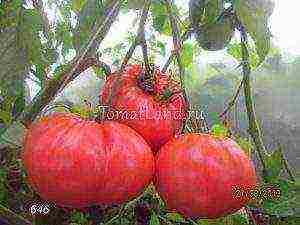Content [show]
If you still think that echinacea is such a nondescript pink chamomile with a convex center, which is used in medicine, then you are a little behind the times. In fact, the best modern varieties of echinacea are able to compete in beauty with dahlias and asters, and reproduction, planting and cultivation of echinacea are so easy that even a beginner can handle it.

Therefore, we invite you to look in a new way and reevaluate this interesting, beautiful and non-capricious plant, learn about its medicinal properties, the possibility of using it in the design of a garden plot, the brightest varieties, the history of "conquering the world", and, of course, about how to grow echinacea.
Echinacea: a little history
The name of the hero of our article comes from the Greek word echinoc - that is, "hedgehog". Echinacea was first described in 1753 by Karl Linnaeus, who referred it to the genus Rudbeckia, calling it rudbeckia purpurea. Much later, Echinacea was separated into a separate genus of the same name, to which today 10 species belong. Most often in medicine (both folk and official), as well as in gardening, Echinacea purpurea is used.
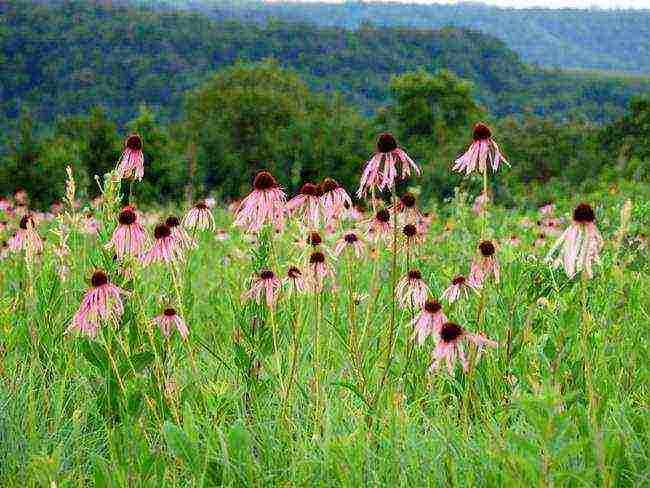
She comes from the North American continent, its eastern part, where she prefers to settle on the prairies, in the fields, on rocky hills and sandy river banks. In Europe, the existence of echinacea was learned after the discovery of America, and until the 30s of the twentieth century it was used only as a medicinal plant in traditional medicine. Fortunately, in 1938, Dr. Madaus from Germany became interested in her. He carefully studied the chemical composition of echinacea, described the possibilities of its use in official medicine, opening the way for drugs with echinacea to the pharmacy counters.
And from about the 50s, American, Belgian, Norwegian, Soviet, Italian, French and other gardeners took up breeding work, breeding more than a hundred not only healing, but also very beautiful varieties.
Echinacea: botanical features
Echinacea purpurea (Echinacea purpurea) is a herbaceous perennial about one meter high, with a restrained, discreet beauty. The stems of this plant are erect, from half a meter to a meter high, and sometimes up to one and a half meters. The root system is branched, with many shoots that penetrate the soil to a depth of 0.2-0.3 m. The leaves are collected in a rosette, broadly lanceolate, and the basal ones are located on elongated petioles, and the stem ones - on shorter ones. Echinacea blooms, mainly in summer, and blooms for one and a half to two months in large flowers with a basket diameter of 10-12 cm.

A characteristic feature of the flower is a convex center and rigid petals. Inflorescences, as a rule, crown the top of the stem or grow from the axils of the upper leaves. Echinacea fruits are small (5-6 mm in length) tetrahedral achenes.
The healing properties of echinacea
For medical purposes, all parts of Echinacea that have reached the age of two to three years are used.First of all, Echinacea purpurea is a powerful immunostimulant for physical and mental fatigue, after radiation and cytostatic therapy, antibiotic treatment. This plant promotes the release of interferon, a protein that is responsible for enhancing the body's immunity. If you take the correct dose of echinacea tincture at the beginning of the disease, you will recover faster, guaranteed.
Particularly noteworthy is the fact that the use of drugs based on echinacea for a long time does not cause addiction and does not depress the nervous system.
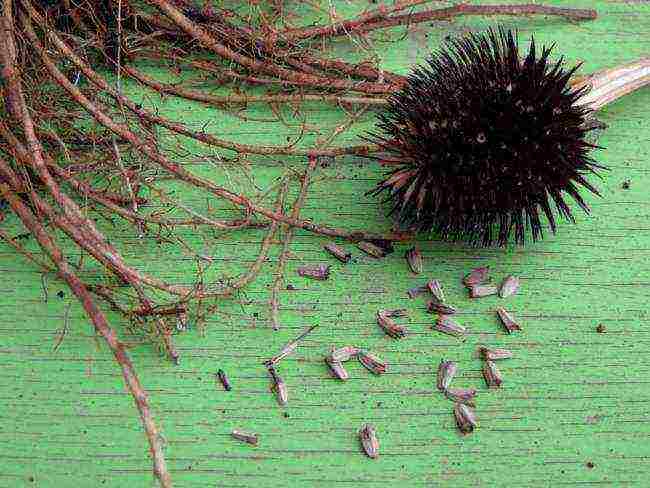
In total, at the moment, almost two and a half hundred drugs have been patented in the world, which include echinacea, including a drug for the treatment of AIDS.
Echinacea stems and roots even the Indians used it for snake and insect bites. And they are still actively used to treat burns, wounds, poisonous bites. And also Echinacea roots are a strong metabolic stimulant, adaptogen, aphrodisiac, antiseptic and very good diaphoretic for colds.
Professor Sergei Arkadievich Tomilin at one time compared the medicinal properties of echinacea with ginseng, and was one of the first scientists to recommend using it for depression, overwork, parametritis, sore throat, inflammation of internal organs, typhoid fever, tonsillitis, diphtheria, erysipelas, cerebral meningitis , osteomyelitis.
In addition, we add that the juice from the fresh inflorescences of this plant has a beneficial effect on the healing process of wounds in severe bedsores and burns of the first or third degree, improves blood clotting.
Preparations containing echinaceaare also used to treat diseases caused by exposure to pesticides, fungicides, insecticides, heavy metals and other chemicals found in food and in the air.
But, nevertheless, not a panacea - echinacea: contraindications she also has. In particular, echinacea should not be taken by nursing and pregnant women, with multiple sclerosis, leukemia, collagenosis, progressive tuberculosis and people in whom this plant causes a severe allergic reaction. Thus, use of echinacea preparations possible only after a doctor's appointment.
The best varieties of echinacea: photo, description
Echinacea, depending on the variety and hybrid, may not be traditional pink (raspberry, cherry), but also orange, and yellow, and white, and even green. But, regardless of color, all varieties have large, eye-catching inflorescences, and a pleasant aroma.
Echinacea Doubledecker
Let's start with the most unique - so far the only, stunningly beautiful semi-double variety. Its flowers are pale pink with a "tuft" of different colors (a mixture of green, dark and light pink, dark and light green petals). It is a hardy Echinacea variety that blooms from July to September. Very picky about the sun, the height is no more than half a meter.

Echinacea Double Scoop Cranberry
One of the most new varieties of echinacea, is characterized by increased drought and frost resistance. It blooms in June-August with large double flowers of the color of ripe lingonberries. The height of the bush itself is up to 60 cm. It can be used for cutting. Very picky about the variety.
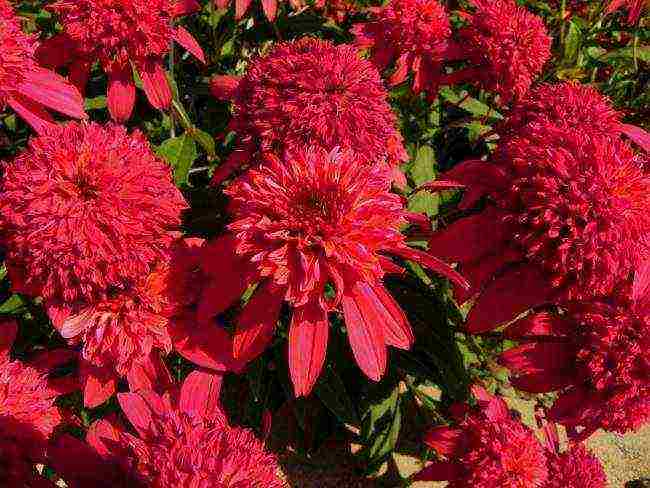
Echinacea Supreme Flamingo
This variety stands out for its soft coral or soft pink double flowers, exuding a wonderful aroma. It blooms all summer, the height of the bush is up to half a meter. Feels good exclusively in sunny places.
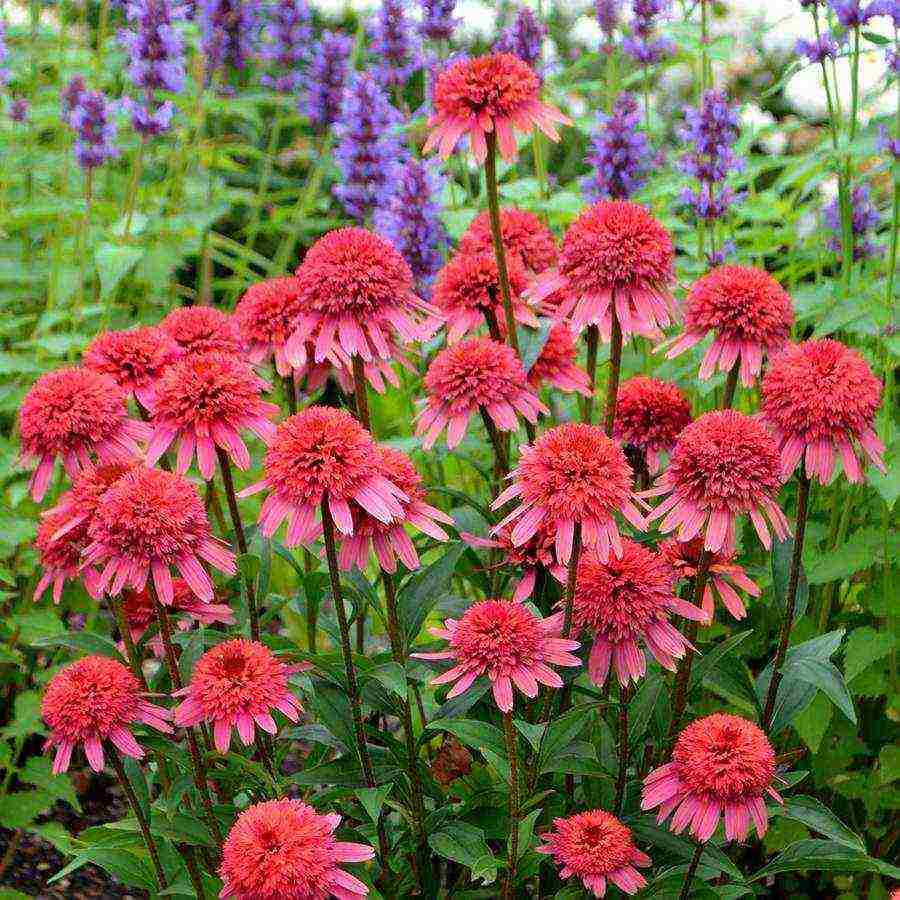
Echinacea Supreme Cantaloupe
This variety has large salmon-colored double flowers, very fragrant. The height of the bush is more than 70 cm. It blooms in June-October, needs sunlight.
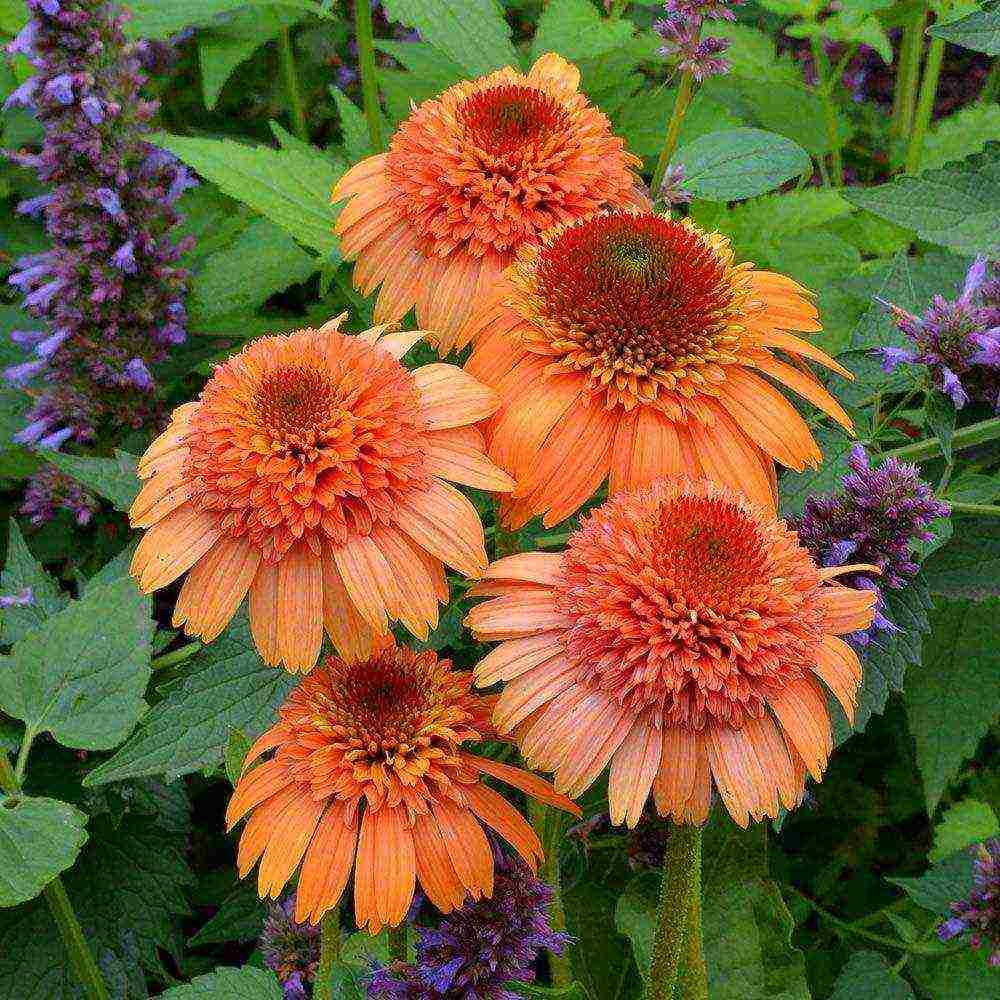
Echinacea Secret Passion
A frost-resistant variety with a bush height of up to 60 cm, blooms in July-October. Its flowers are large, double, with a rich pink center and pale pink lower petals. Disembarkation is recommended only in sunny places.

Echinacea Secret Affair
This variety is distinguished by its deep burgundy double flowers and its tolerance to light shading. The height of the bush is up to 60 cm, flowering is observed in July-September. The variety is frost-resistant.

Echinacea Meringue
It is a short echinacea (30-60 cm), with full white flowers, hardy, requiring sunny places for planting. Blooms in June-August.

Echinacea Meteor Red (Meteor Red)
A frost-resistant variety with bushes up to 60 cm high, and large double flowers with rich red upper petals and orange-red lower ones. Blooms in July-September, can grow in slightly shaded areas.

Echinacea Eccentric (Eksentrik)
The main feature of this variety is a very long flowering period, from June to October. The variety is frost-resistant, tolerates slight shading. The height of the bush is up to 60 cm, the flowers are large, double, red, in the middle with a purple tint.
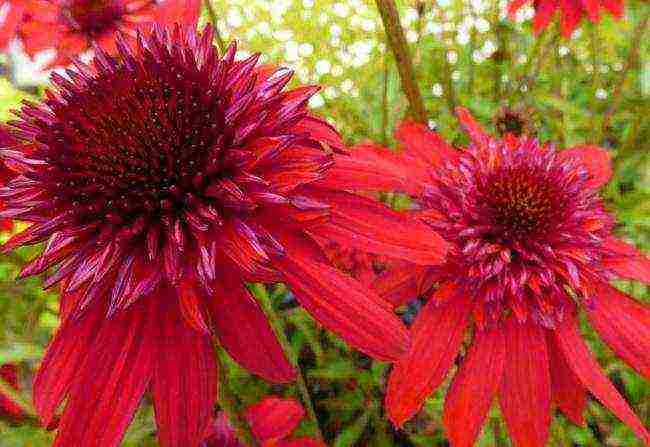
Echinacea Coconut Lime
A frost-resistant variety with a unique color: the upper petals are bright light green, the lower ones are white. The color itself is terry, large, and the bush is high - up to 70 cm.Flowering is observed in July-September. The variety is loyal to shaded areas.
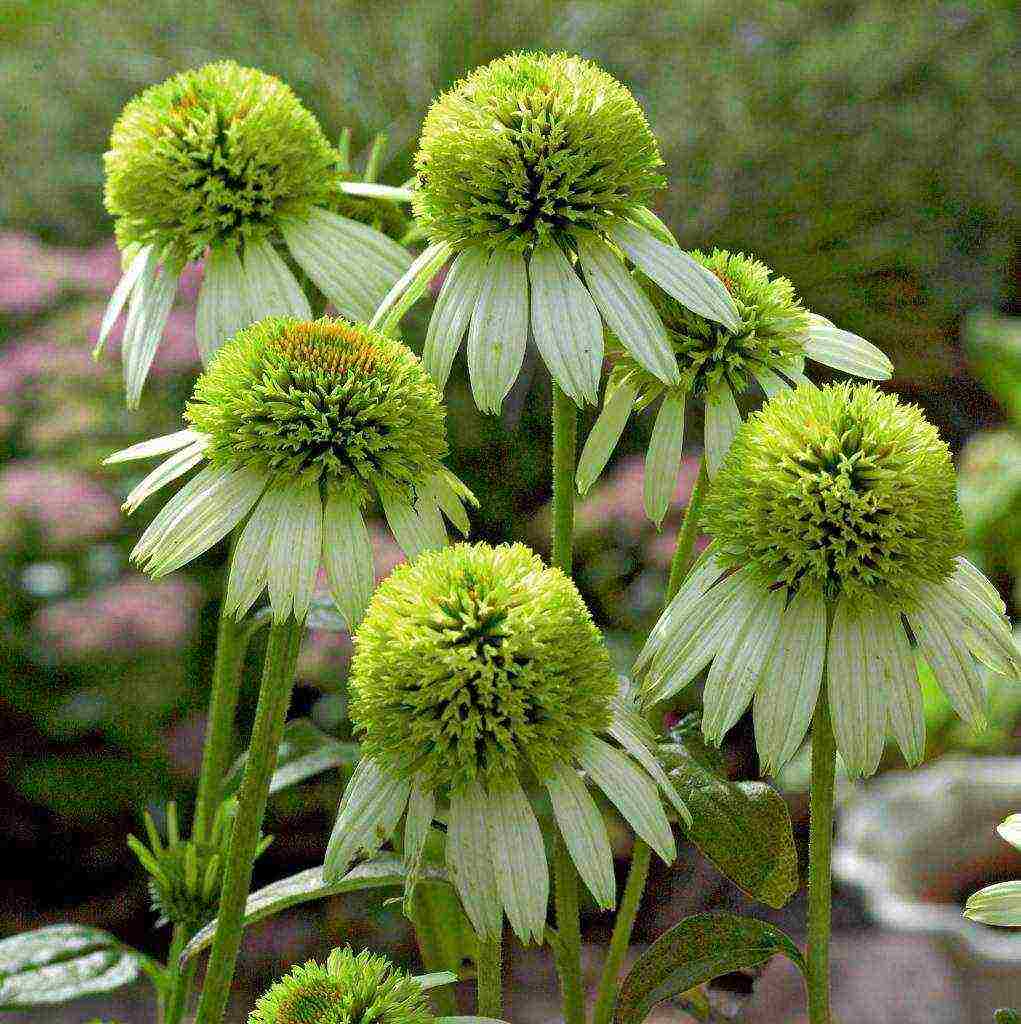
Echinacea: cultivation and care
In addition to its stunning appearance and medicinal properties, echinacea can please with one more advantage: unpretentiousness to growing conditions and ease of care.
Planting site for echinacea
Echinacea is sun-loving, but some varieties feel good in light partial shade, it tolerates heat and summer drought well, as well as severe winter frosts. When to plant echinacea? Around the end of spring, a distance of half a meter or a little more is left between the plants. As for the soil for echinacea, the main thing is that it is not acidic and not soggy, rich in organic matter.
Echinacea care: watering and fertilizing
On windy and hot days, as well as during prolonged droughts, echinacea must be watered regularly, preferably in the late evening or early morning.
Echinacea is fed every year: at the end of May or at the beginning of June, 20 g of complex mineral fertilizer is added to a bucket of irrigation water, and after a month and a half, the top dressing is repeated. And after the autumn pruning of the stems, a generous layer of compost mulch is laid.
Echinacea pruning
In order for the plant to bloom longer and more abundantly, the faded peduncles should be removed. In the fall, all branches are cut to a level with the ground, and in the spring, the damaged parts of the bush are cut off.
Preparing echinacea for winter
Like all herbaceous plants, the terrestrial part of Echinacea dies off for the winter. It does not require special shelter for the winter - just thoroughly mulch it. In the spring it wakes up quite late, in May, and if the spring is cold, even later. But unexpected spring frosts are not terrible for her.
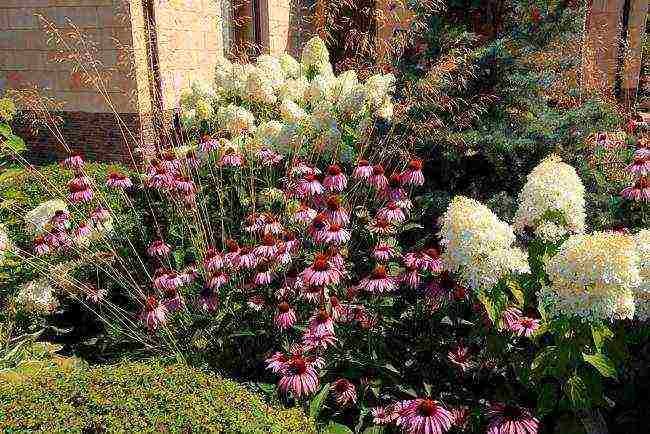
Reproduction of echinacea
Echinacea propagation is carried out either by dividing the bush or by seed.
The division of the echinacea bush, unlike most herbaceous plants, is carried out not in late summer or autumn, but in spring - before the leaves have completely blossomed, and the bases of the shoots are lignified. Before planting, root cuttings and cuttings are recommended to be kept in a liquid solution of an immunostimulant for several hours. When planting, make sure that the root collars are flush with the ground.
Sowing of echinacea seeds is carried out in the spring, so that before the onset of cold weather the seedling has time to take root and bloom the next year. It is best to germinate the seeds in advance. To do this, in February, they are sown in a box with soil to a depth of 0.5-1 cm, sprinkled with a thin layer of sand, carefully watered and placed in a warm place. Seeds hatch in 15-35 days. The seedlings are transferred to open ground in early May. If you sow echinacea seeds directly into open ground, you should do this no earlier than May, when the threat of night frosts has passed.
Echinacea diseases and pests
Echinacea is fairly resistant to disease and pests, and if provided with good soil, suitable sunshine, and minimal proper maintenance, it shouldn't be a problem.
However, diseases do occur in echinacea. In case of waterlogging of the soil, first spots appear on the leaves, then the plant begins to wither, in extreme cases - dies. In conditions of high humidity, the plant becomes an easy prey for fungal diseases, so at the first alarming symptoms, immediately stop watering and remove the affected leaves. If the disease covers echinacea entirely, you will have to use fungicides.
If the plant has deformed peduncles, and the leaves turn yellow and stripes appear on them, most likely, we are talking about a virus. Echinacea treatment in this case will be ineffective - the affected specimens are removed from the site and burned.
Echinacea in the garden
Echinacea looks very impressive in mixborders, planted in separate large groups of different varieties in the middle levels of mixed flower beds, as well as against the background of tall trees. And for the front line of mixborders, undersized varieties of echinacea are well suited.
This plant goes well with perennial low-growing grasses, looks good in gardens in a natural style. Echinacea will always look like a bright spot in the garden, attract birds and butterflies, and if you do not remove the seed boxes for the winter, you will also get a pretty decoration of the winter garden.
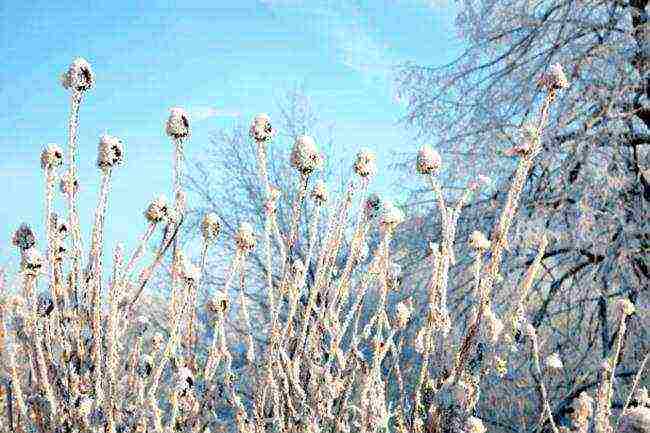
Echinacea in the garden is well adjacent to rudbeckia, dahlias, yarrows, monards, ornamental grasses, salvia and other plants. It is also worth mentioning that Echinacea is a first-class honey plant that attracts many bees to the garden.
Thus, such a simple activity as growing echinacea will decorate your site with red, white, coral, pink or cherry color for many years, will become a highlight of a mixborder, and the healing properties of echinacea - from "heels to crown" - will make it an indispensable guest at home. first aid kits.
Tatiana Kuzmenko, member of the editorial board Sobcor of the Internet edition “AtmAgro. Agroindustrial Bulletin "
Echinacea purpurea is an unpretentious plant that, thanks to the sweet aroma of flowers, attracts butterflies and beneficial insects to the garden. It is impossible not to fall in love with these bright flowers with a voluminous core!
Echinacea purpurea blooms from mid-summer to late September. But when the petals wither, fluffy cones continue to flaunt on the stems, in which the seeds ripen. Thus, the plant remains attractive in winter. It is noteworthy that, thanks to its strong stems, echinacea perfectly tolerates heavy rains and gusty winds.
Echinacea does not lose its attractiveness even after the petals wither
Planting echinacea
Echinacea prefers fertile and permeable soil. This flower can also grow on clay soil, but in this case, every 3-4 years the plant needs to be rejuvenated - divided into small bushes. But light sandy soils are not suitable for echinacea.
Echinacea is most often grown in seedlings.
In the spring, holes are prepared for seedlings 5 cm deep. The distance between them should be about 30 cm. A small handful of compost is poured into each hole and one plant is planted there. Then the echinacea is poured with water at room temperature.
When planting an adult plant, a hole is dug from a container about 40 cm deep, 1/3 is filled with a mixture of sand, garden soil and compost (taken in equal parts). The plant, together with an earthen lump, is transferred into a hole to the same depth at which it was in the container.
Echinacea purpurea is best planted in groups in flower beds next to low ornamental plants that will not obscure their sunny flowers.
Echinacea purpurea is not only beautiful, but also a healing plant
Echinacea care
Echinacea loves the sun, is able to withstand short-term drought and does not freeze in winter.What more could a lazy florist want? Just plant it in an open, sunny area and enjoy the lush bloom. Even if you rarely come to the country, bright flowers will not die from lack of care in your absence.
Echinacea purpurea can grow in partial shade, but then its flowers will be less fragrant and pale.
But this does not mean that you can forget about the bright beauty. To keep the flowering lush and long-lasting, water the plant abundantly in the evening.
New varieties of echinacea
Echinacea flowers are not only purple. The petals can be colored in all shades of yellow, pink, red and even green. In addition, today there are varieties with both simple flowers and double flowers. But keep in mind that varietal plants are not as hardy as Echinacea with simple purple flowers. And they do not reproduce by seeds, since the maternal characteristics of the plant are not always transmitted to the “offspring”.
Green jewel
Reaches a height of 60-80 cm. Large flowers change color from light green to yellow-green as they bloom.
Aloha
These pale yellow flowers with a large orange core, like suns, "shine" from June to September. The plant reaches a height of 80 cm.
Big kahuna
Simple honey-ocher flowers bloom in mid-summer.
Leilani
Long bright yellow petals shine beautifully in the sun. The plant blooms from June to September.
Evening glow
Two-color (pink-yellow) petals give a special charm to the plant. Stem height - up to 60 cm.
Secret glow
Unusual terry, anemic shape. The color of the flowers is deep yellow. Plant height - 50-60 cm. Lush flowering lasts all summer and autumn.
Marmalade
This rather large (10 cm in diameter) double orange-yellow flower does not at all look like echinacea. A pinkish tint often appears on the petals, which makes the plant even more attractive.
Supreme cantaloupe
Tall plant (about 80 cm) with delicate apricot flowers with a double core. Abundant flowering is observed from July to September.
Raspberry Truffle
Terry echinacea of a delicate peach-pink color with a darker core. The diameter of the flower is about 7 cm. The height of the plant is up to 55 cm. It blooms in July-September.
Secret love
These double flowers of a bright crimson-scarlet color with serrated petals at the tips bloom profusely from July to September. Plant height - up to 50 cm.
Elton knight
Bright pink-purple flowers with a burgundy cone, in which a greenish core is visible, adorn the garden from July to September.
White swan
Ideal for lovers of chamomile-like flowers. This echinacea has large flowers (up to 15 cm in diameter) with snow-white petals and a yellowish core. The height of the stems can reach 1-1.5 m. Flowering lasts from June to September.
What attractive echinacea have already won your heart?
For several centuries, people have cultivated a variety of flowers from the Astrovye family. The genus Echinocea is no exception. This genus includes about 10 species. Echinacea purpurea is widespread in horticulture, as well as varieties and hybrids obtained with its participation. Thanks to many years of breeding work in recent decades, plants with flower color have been obtained:
- white
- orange
- yellow
- red
- purple
We will try to figure out where the echinacea will take root, in planting and caring for and after it, how to choose a place for it and in the best varieties of plants for the garden.
Content:
- How to choose a place for echinacea, the best varieties for the garden
- Planting echinacea in the garden
- Echinacea care
How to choose a place for echinacea, the best varieties for the garden
The plant was first discovered in the eastern part of the modern United States. In the 18th century, the taxonomist K. Linney attributed the plant to the genus Rudbeckia. Several decades later, several differences between echinacea and rudbeckia were noticed and the plant was isolated into a separate genus.
It turns out that the bracts in rudbeckia are soft, and in echinacea they are not only harder, but also prickly. It is for this that the flower got its name from the Greek word prickly. When choosing a place for echinacea, you need to remember that it is most often cultivated as a perennial herb and will grow in the garden for several years in one place.
Lighting and soil
Echinacea's need for sunlight is quite high. If possible, it should be planted in a sunny place. In extreme cases, the flower can grow either in partial shade, or with a sufficiently long period of continuous illumination during daylight hours.
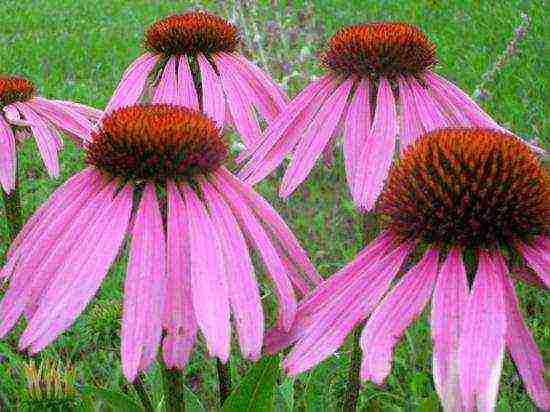
There are no special requirements for the mechanical composition of the soil for planting echinacea. The plant grows well on the most wasteful lands. In their homeland, they chose railway embankments and settled them by self-seeding. Echinacea can grow in any area with moisture-permeable soil.
It is desirable that it was earth with a neutral or slightly alkaline reaction. To create more favorable conditions, you will need fertile soil with good moisture.
In a dry summer, additional watering is needed every 5 - 6 days, without this, the flowers may lose their decorative appearance and reduce the number of buds. Winter hardiness is an important characteristic. Almost all cultivated varieties hibernate without shelter. In very harsh winters, you can cover it with spruce branches.
Variety selection
When choosing a variety of echinacea, you should consider its purpose in the garden. This plant can be curb, used in mixed plantings, grow in separate groups. Echinacea is also grown for cutting and for use in winter dry compositions. Echinacea has two types of flowers, they are collected in the inflorescences of the basket.
Echinacea cultivation video:
Reed flowers are located along the edge, they are elongated, up to 4 - 8 cm. Tubular flowers are collected in the center, they are most often red or brown. Now varieties with double flowers have been obtained. In addition, echinacea is classified as a medicinal plant and is widely used in folk medicine.
The best varieties and hybrid forms are:
- Piccolino - dwarf variety, no more than 0.3 m high, double flowers
- Little Magnus - low grade, 35 - 46 cm, purple flowers with a bright orange - bronze center
- Irresistible - medium-sized variety, up to 80 cm, double flowers, red-orange
- Southern Belle is a tall variety, more than 1.0 m in height, one of the first to bloom and blooms continuously up to 12 weeks, flowers are medium-sized, pink, double
- Mikshake - a bush up to 0.9 m high, opens up to one hundred flowers at a time, flowers are white, double, in the form of pompons
We will try to figure out how and when it is better to plant echinacea.
Planting echinacea in the garden
There are three main ways to dilute echinacea in the garden. This is done either by direct sowing of seeds directly into the ground, or by sowing for seedlings, or by dividing the bush.
Sowing echinacea for seedlings, care after planting
This method should be used when breeding rare varieties and a limited number of seeds. Sowing seedlings is carried out around mid-March. Seeds are placed in planting boxes with neutral, pre-moistened soil.
The top is covered with a thin layer of sand and it is also sprayed. The emergence of seedlings can be observed after two to three weeks. Although there are cases of seed germination in the fourth - fifth week.
Seedling care is reduced to systematic soil moistening. In mid-May, seedlings are planted in a well-dug garden bed. It is advisable to add rotted manure for digging. Immediately after planting, echinacea is well watered before rooting. In the future, care is reduced to removing weeds and loosening the soil.
Sowing seeds in open ground and reproduction
Echinacea seeds are sown on the prepared place in the second decade of May. The sowing site is regularly moistened. Seeds begin to germinate in two weeks. They are looked after in the same way as when growing seedlings.
In early spring, as soon as leaves appear on the surface, the bush is dug up and divided into 3-4 parts. Dividers are laid out in the prepared holes and covered with soil. It is important to leave the root collars above the ground.
Echinacea care
The plant does not require special care. It is important to regularly remove weeds, loosen the soil and in hot weather arrange a warm spraying on the plant. If you regularly cut off the baskets of inflorescences that are already fading from echinacea, then you can achieve abundant long flowering.
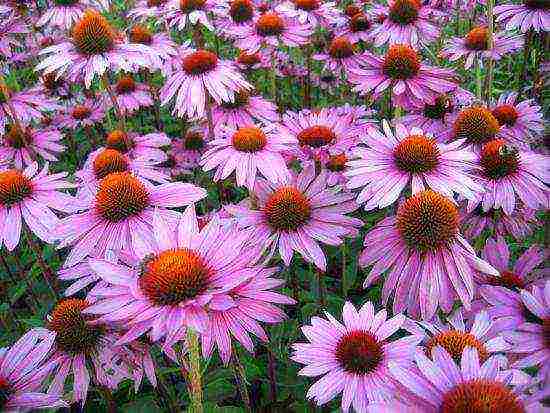
Plants are resistant to diseases, but with excess moisture they can suffer from fungal diseases. In order to avoid fungal infection, it is important to observe the humidity regime. If the plant is sick, then it can be sprayed with a solution of any fungicidal agent, after removing the affected parts.
If planting and care are organized correctly, echinacea will delight with its flowering in the garden, and when cut into bouquets, it will become a decoration for the home.
Main page ›Forums› Flower garden and landscape ›Ornamental plants and their care› Interesting and unusual varieties of Echinacea
This thread has 17 replies, 2 participants, last updated Maxim Savinov 4 months. back.
Viewing 10 posts - 1 through 10 (of 18 total)
-
author
Posts
-
Echinacea purpurea 'Cherry Fluff' (Echinacea purpurea ‘Cherry Fluff’).
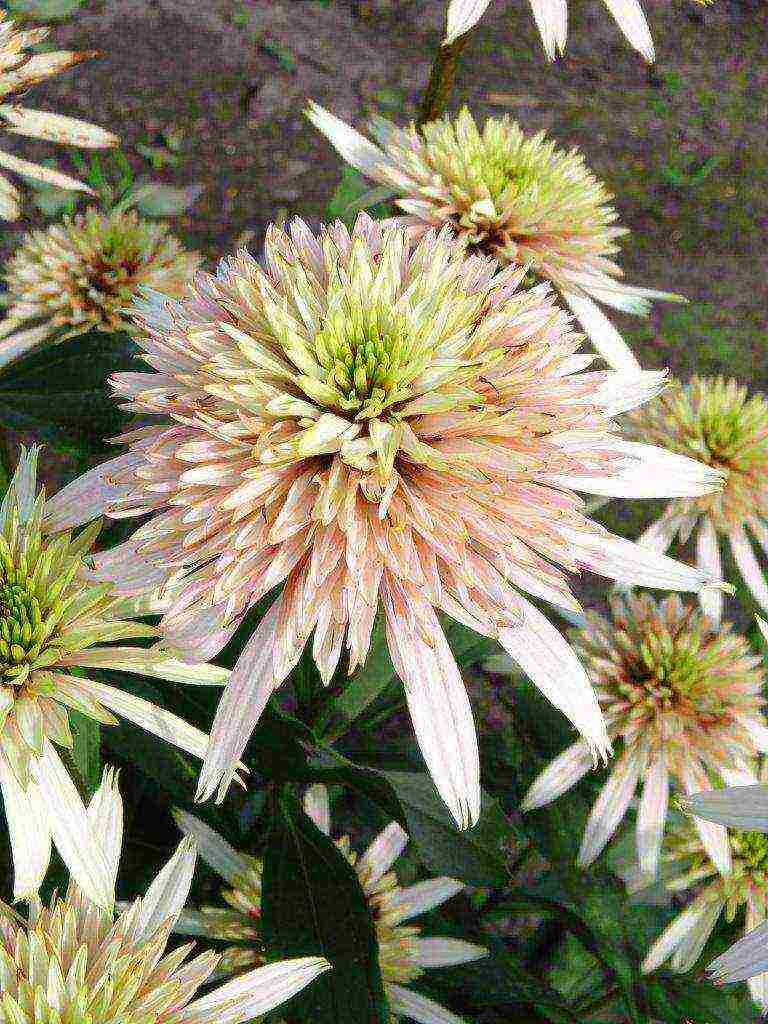
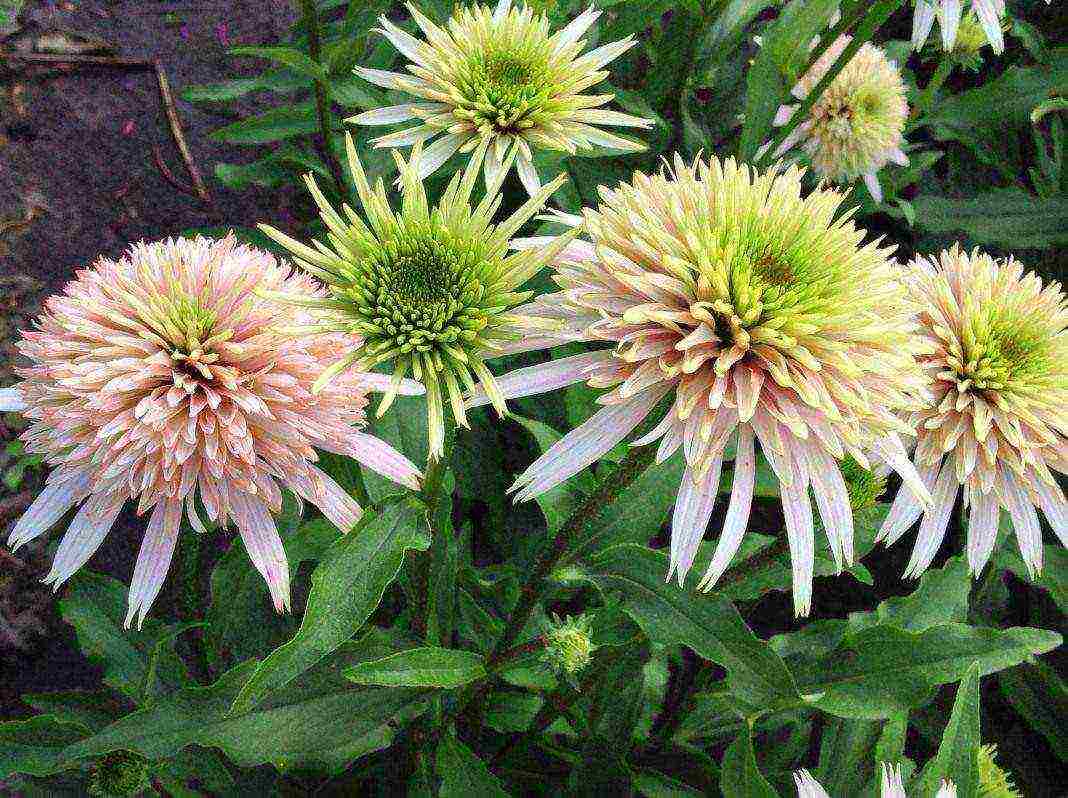
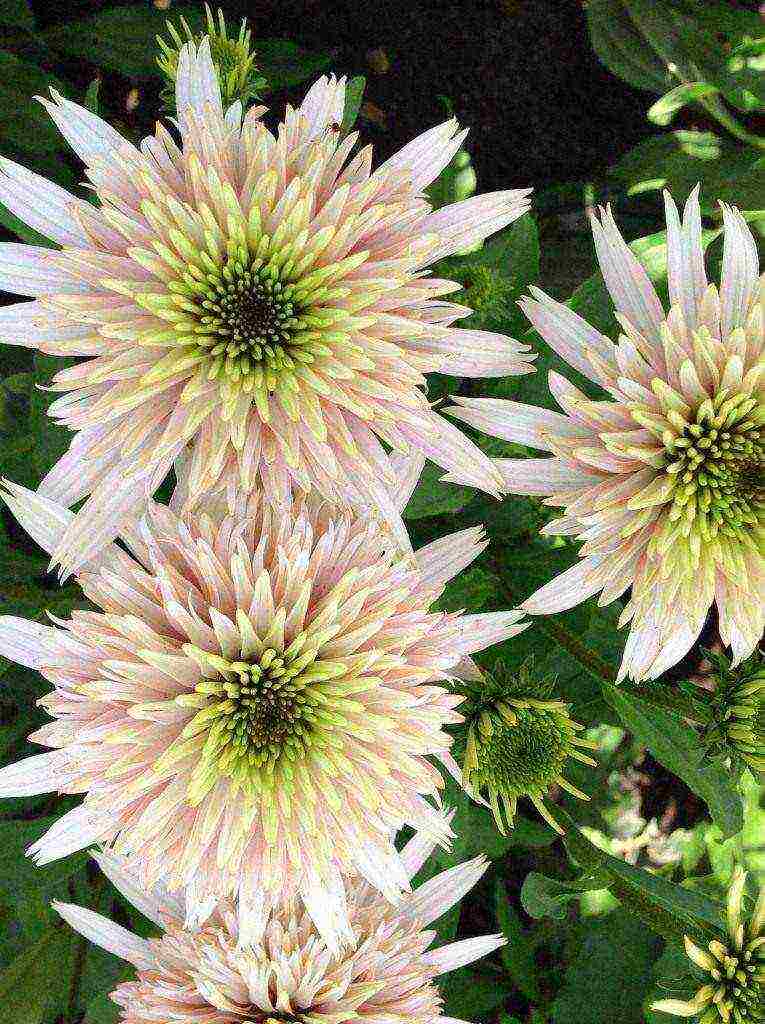
This theme was created to publish photos and descriptions of new, interesting or simply beautiful varieties of Echinacea. Place "your" varieties in the answers to this topic.
Viewing 10 posts - 1 through 10 (of 18 total)
You must be logged in to reply to this topic.


